How to Cite | Publication History | PlumX Article Matrix
R. Tamilchudar1* , R. Arivuchudar2
, R. Arivuchudar2 and B. Sendilkumar3
and B. Sendilkumar3
1Department of Optometry, School of Allied Health Sciences, VMRF-DU, Salem, Tamilnadu, India.
2 Department of Nutrition and Dietetics, Periyar University, Salem, Tamilnadu, India.
3 Dean, School of Allied Health Sciences, VMRF-DU, Salem, Tamilnadu, India.
Corresponding Author E-mail: tcopto@gmail.com
DOI : http://dx.doi.org/10.13005/bbra/3229
ABSTRACT: Accommodative insufficiency or Accommodative disorder is a sensory-motor abnormality, non-strabismic binocular vision abnormality, which is manifested by a failure to focus for near vision, with a decreased degree of accommodation in comparison with age-matched norms. The symptoms include vague, blurry near vision, headache, visual exhaustion, difficulty in reading, eye strain and sleepiness. This study has tried to explore the impact of anemia on accommodative disorder among college children and found a correlation between them. The results showed a statistically significant association between anemia and the occurrence of accommodative disorders. Hence nutrition education was given as a means to impart knowledge on overcoming anaemia and accommodative disorder among the selected college students.
KEYWORDS: Accommodative disorder; Anemia; Binocular Vision; Eye; Education
Download this article as:| Copy the following to cite this article: Tamilchudar R, Arivuchudar R, Sendilkumar B. Elucidating the Impact of Anemia and Nutrition Education on the Accommodative Disorder of Eye among the College Students. Biotech Res Asia 2024;21(1). |
| Copy the following to cite this URL: Tamilchudar R, Arivuchudar R, Sendilkumar B. Elucidating the Impact of Anemia and Nutrition Education on the Accommodative Disorder of Eye among the College Students. Biotech Res Asia 2024;21(1). Available from: https://bit.ly/3IKyhiE |
Introduction
Anemia is manifested by a reduced load of red blood cells(RBC) or Haemoglobin (Hgb) concentration1, the iron-containing oxygen transport metalloproteinase present in red blood cells. Causes of anemia include iron, folate, and vitamin B12 deficiencies. Anemia causes physical health hazards affecting developing and developed countries impacting socio-economic progress, varying with individuals age and sex.
The WHO estimates that 2 billion people worldwide suffer from anemia, and nearly 50% of all anemia is caused by iron deficiency 2,3 which averages to 24.8 percent. The worldwide occurrence of anemia among adolescents was 27% and 6% in developing countries, and developed countries respectively4. Also in the study among Ethiopia country, prevalence rates found in school adolescents were almost about 3% to 15% and 9.5% to 35% in 15 to 19 years of males and females5,6. Globally, in 2019 the pervasiveness of anemia among non-pregnant women aged 15 to 49 was 36% 7. The prevalence rate of 13-17 year old adolescent school girls was found to be almost 79%, a higher rate found in Chennai, Tamil Nadu (among both public and private schools)8. A recent study conducted by the medical department of Vinayaka Mission Medical College and Hospital in Karaikal, which conducted a medical camp in rural Selmavilangai village, found that the incidence of anemia in women aged 18 to 45 years was 36%. A study done in the tertiary care hospital of Salem among the age group of 18-22 years shows that it is almost about 31%.In another study conducted among health science students of Tamil Nadu, South India at the age of 18-45 years, the prevalence was almost 43%. To the best of our knowledge, women and children are most affected by low levels of hemoglobin.
Anemia plays an important role in causing eye problems like retinopathy, optic neuropathy, vision functional loss, and defective eye movements9.Another mechanism is deficiency of iron in blood which leads to the major cause of the weakening of muscles. The author speculates that in chronic cases, a careful prismative examination might identify a certain weakness in the extraocular muscle balance10. Problems caused by iron deficiency anemia, the accommodation is one of the major factors affecting predominantly by the weakening of ciliary muscle.
“Accommodation” is the method by which the eye alters refractive error by varying the shape of its crystalline lens. Accommodative or refractive esotropia may occur due to efforts to use eye muscles to focus the clear viewing of closer objects. The vital feature of the accommodation is “an increase in the curvature of the lens,” chiefly affecting the anterior surface.
The two types of accommodation are, physical accommodation (ability of the lens to alter its shape) and physiological accommodation (power of the ciliary muscle to contract) 11,12. Since there is considerable evidence about the function of iron in the CNS of animals, it is imperative to investigate the effects of iron on human eye health 13,14,15. This anemia has the effect of influencing body behaviors and mental development and also has the effect of causing CNS disease, which is innervated by eye muscles (cranial, abducens, and trochlear nerves), thereby affecting the accommodations of binocular functions too.
Literature states that the etiology of anemia is higher among children and adults in India; this probes us to find out the incidence of anemia among college students and also to evaluate the relationship between adolescent anemic disorder and accommodative dysfunctions and as well as earlier reports have discussed the impact of childhood anemia and binocular dysfunction, as there were no studies found on the relationship on college students with anemia and accommodative disorders. So, we aim to understand the relationship between anemia and accommodative disorders among college students which helps us to prevent the accommodative disorders of the eye in earlier stages. Also, this study was carried out to find out the incidence of anemia among college students and to reduce the prevalence rate among anemia and accommodative disorders. This will bring the awareness to this study report.
Materials and Methods
It is a prospective study of anemic disorder among college students within 17-23 years of age. Sample size was calculated using the single proportion formula by taking the level of confidence at 95%, margin of error 5%, and an expected prevalence maximum of 43% according to previous prevalence study reports. The sample size calculation is considered with a precision /absolute error of 5% and a type I error of 5%. Hence the formula of sample size =1.962×0.43(1-0.43)/0.052 =377 subjects. A total of 394 subjects were enrolled for the study. The investigation included the patient’s haemoglobin count, which was evaluated by using a haemoglobin counting monitor, followed by which the samples were divided into two groups, one as Anemic disorder group (cases) and the other is non-anemic as a control group. According to WHO, those with hemoglobin level (mg/dl)in the range of 12 or higher were considered the Non-Anemic and those with a lower range of this were considered to have an Anemic disorder and for both the group’s further tests, such as visual acuity test using Snellen’s visual acuity chart, Extraocular muscle action was evaluated using Broad H test, Near point of accommodation was measured by RAF ruler, Positive Relative Accommodation and Negative Relative Accommodation were measured by using positive and negative trial lenses, Accommodative facilities checked using accommodative flippers, color vision was evaluated by using Ishihara color vision chart and also an anterior and posterior segment of the eye was evaluated using a slit lamp.
Inclusion criteria
College students within 17-23 years of age with anemia after evaluating the hemoglobin level using a Hemoglobin- meter are considered as cases (one group) and without Anemia as controls (Other groups) will be included in the study.
Exclusion criteria
Age groups other than 17-23 years will be excluded
Previous H/O Ocular treatment /therapy
Previous H/o Ocular trauma
Congenital abnormalities in the eye like lens coloboma etc.,
Crystalline lens dislocation
Systemic diseases which causing secondary disorders of anemia will be excluded
Results and Discussion
Socio demographic Characteristics of the participants
2000 volunteer participants were screened to rule out anemia and binocular disorder. A total of 81 anemic cases were diagnosed and 1919 were non-anemic. For statistical purposes, 394 subjects were recruited as mentioned in the study sample calculation and it was found that 81(20.6%) of them were anemic and 313(79.4%) were non-anemic. Age-wise distribution of participants is presented in figure 1.
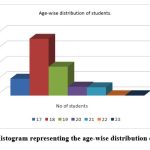 |
Figure 1: Histogram representing the age-wise distribution of students. |
The participants age ranged between 17 to 23 years with a mean of 18.27 ± 0.8 years. Of the high percent of participants from age of 17 years which was 46 (56.7%) were anemic and 139 (44.4%) were normal controls. In Anemic cases, 71 (87.6%) were female and 10 (12.3%) were male. When compared to other studies7, 8, this study also found that anemia is more prevalent among females when compared to male. This speculates that the women should concentrate on iron rich foods in their diet for healthy well-being.
Distribution of NPC and PFV among Anemic cases and control
Of the total participants, 231 (58.6%) were with Near Point of Convergence (NPC) of 6-10 cm, from them 52 (22.5%) were found to be anaemic and 179 (77.4%) were normal controls. 26 (6.5%) of participants had receded NPC (>10cm), from them 14 were anemic and 12 were normal which was found to statistically significant (P<0.05) and is represented in figure 2 and Positive Fusional Vergence (PFV) breakpoint and recovery point represented in figure 3.
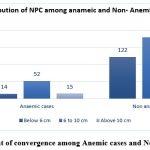 |
Figure 2: Near point of convergence among Anemic cases and Non-Anemic controls |
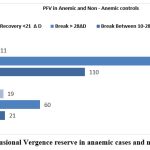 |
Figure 3: Positive Fusional Vergence reserve in anaemic cases and non-anaemic controls Click here to view Figure |
The amplitude of accommodation among anemic cases and controls
The amplitude of accommodation was calculated by using Hofstetter’s formula was 18.5 – (0.3×patient’s age in years). About 2.2% of normal subjects had accommodation of 11.6D and 25.9% of anemic cases had accommodation of 11.6D. The anemic subjects had the lowest amplitude of accommodation compared to controls which were statistically significant at 1% level (P<0.01) fig 4.
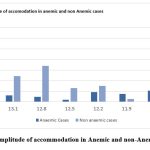 |
Figure 4: Amplitude of accommodation in Anemic and non-Anemic controls. |
The Monocular Estimate Method (MEM), monocular and binocular facility among Anemic cases and controls
The MEM was performed by using retinoscope and found that Anemic cases have lag of accommodation (≥+0.75) when compared to the controls. The monocular and binocular accommodative facility for anemic cases were assessed and found that 35.8% of anemic cases and 4.1% of non-anemic controls have difficulty in minus lenses which indicated that stimulation of accommodation is difficult for anemic cases compared to normal controls (figure 5).
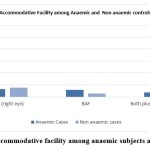 |
Figure 5: Accommodative facility among anaemic subjects and control Click here to view Figure |
Distribution of binocular condition in anemic patients
In Anemic cases, about 39.5% had convergence insufficiency and 30.8% had accommodative insufficiency which implies that anemic cases had higher level of abnormal binocular condition compared to controls represented in table 1.
Table 1: Abnormal binocular condition in Anemic and non-Anemic controls
| Condition | Frequency | Percent | Valid Percent | Cumulative Percent |
| Ortho | 24 | 29.6 | 29.6 | 29.6 |
| ConvergenceInsufficiency | 32 | 39.5 | 39.5 | 69.1 |
| Accommodation Insufficieny | 25 | 30.9 | 30.9 | 100.0 |
| Corneal Excess | 0 | 0 | 0 | 100.0 |
| Accommodation Excess | 0 | 0 | 0 | 100.0 |
| Total | 81 | 100.0 | 100.0 |
Iron deficiency anemia is considered the most common nutritional disorder all over the world. In general, one in three people in South Asian countries suffers from some form of malnutrition, that result from low quality diet, health care environment, low economic development, inequality and dimensions of globalization9.In India too, the percentage of undernutrition and overnutrition were also not so different. The reason for India’s malnutrition is that 80-85% of the population eats energy-dense foods rather than micronutrient-rich foods. In fact, obesity does not mean that there is a healthy body, but also there is a lack of nutrition. The frequency of iron deficiency and succeeding anemia rises at the beginning of adolescence. In our study, the overall pervasiveness of anemia was found to be 20.6% (n=81) and non-Anemic controls were absent at 79.4% (n=313). Another study conducted at the Kerala Government Medical College among adolescent girls aged 10 to 19 found a prevalence of approximately 21% 6. In our study, anemic female subjects were 71 and male subjects were 10. Surprisingly, therefore, we recommend that male subjects also should focus on food intake for healthy well-being. A previous study found that the onset of symptoms such as headache or discomfort after close work is an explicit consequence of a haemorrhage or menstrual pathology for anemia. Such conditions endow with supplementary source for a latent muscular imbalance to occur, even where no imbalance existed previously. When convergence insufficiency occurs in women of younger age, the anemia appears to be more than causally related to the muscle imbalance, or is itself a cause in the absence of a previous imbalance 10-13.
Many studies have evaluated the outcome of iron deficiency anemia on the functional status of the visual pathway and found that Iron deficiency anemia has appreciably longer absolute peak latencies of VEP when compared to the controls 14, 15. Saif Hasaam Alrasheed et.al found that anemia in children has a blow on binocular functions, and impairs binocular stability, leading to convergence insufficiency, reduced accommodation, and a positive fusional reserve 16.The present study analyzed the binocular condition in anemic and normal controls and found that anemic cases showed receded NPC and low PFV values indicating convergence insufficiency. The convergence mechanism is more efficient due to insufficient fusional divergence, and increasing esotropia occurs in particular. Convergence is a component of the near-reactive triad, along with lens accommodation and miosis. We also evaluated the relationship between anemic disorder and accommodative dysfunctions, the percentage for accommodation insufficiency was 31%. The accommodation insufficiency in anemic patients is because of the pressure on the central nervous system, which may impact the function of the ciliary muscle, in controlling the accommodation process. However, Umit Sarci et.al found that the post-treatment visual evoked potential N2 latencies decreased significantly compared to the pre-treatment values this result suggests that iron deficiency anemia causes subclinical visual impairment. So we put forward an important point that iron-rich food, nutritious food is recommended. The limitations of the study include:
The ocular symptoms among anemic cases and controls were not examined,
The angle of deviation at near and distance were not examined,
The lack of literary sources from research studies on the effect of anaemia on binocular function among college students to compare our study finding with them, and
The specificity and sensitivity of the haemoglobinometer device was unknown.
Our major strength is that our study is the first to find an association between anemia and accommodation disorders in college students, and the results showed a statistically significant association between anemia and the occurrence of accommodative disorders. The correlation of organic debility with convergence and accommodation has been predictable and orthoptic exercise and vision therapy are important in improving those debilities.
Conclusion
The study found a statistically significant association between anemia and the occurrence of accommodative disorders. The hemoglobin status of the individuals with symptoms of accommodative disorder should also be examined. Nutrition education on the role of iron-rich foods, folic acid-rich foods, B12-rich foods, vitamin C and protein rich foods was given to decrease the severity of anemia among the anemic subjects. Also, adults with anemia need to evaluate their binocular functions during any eye examination.
Recommendation
A long-term occurrence of accommodation insufficiency and convergence insufficiency may lead to spasms which will affect their daily life activities. In the cases of anemia, a Lack of awareness about the anemia may cause consequences in the maternal life period which may also affect the child’s health. So, college students should aware of their dietary intake and anemic status. Thus, for any college student with anemia there is a vital necessitate for appraising their binocular functions with any type of eye examination. It is also recommended that, measuring students’ hemoglobin levels along with eye exams to rule out refractive errors, eye diseases and anemia.
Future scope
Longitudinal research is considered necessary to understand the effect of post-anemic treatment on binocular function. It is useful to measure the student’s hemoglobin level along with an eye exam to rule out refractive error, eye disease, and anemia. One of the barriers to checking anemia in girls is the fear of needle pricks, therefore in future, a non-invasive screening instrument to rule out anemia will enhance the diagnosing method and being aware of early treatment will improve the student’s health.
Acknowledgment
The authors would like to thank the authors of the literary sources cited in this article and the institution for assisting with funds.
Conflict of Interest
There are no conflict of interest
Funding Source
School of Allied Health Sciences, Vinayaka Mission’s Research Foundation (DU), Salem, Tamil Nadu.
References
- Geneva, S., & World Health Organization. Haemoglobin concentrations for the diagnosis of Anemia and assessment of severity. Vitamin and Mineral Nutrition Information System. Document.2011. Reference WHO. NMH/NHD/MNM/11.1. http://www. who. int/entity/vmnis/indicators/haemoglobin.
- De Benoist, B., Cogswell, M., Egli, I., and McLean, E. Worldwide prevalence of Anemia 1993-2005; WHO Global Database of Anemia.2008
- World Health Organization WHO South-East Asia Region Publications 2006-2010.2011.
- Balcı, Y. I., Karabulut, A., Gürses, D., and Çövüt, I. E. Prevalence and risk factors of anemia among adolescents in Denizli, Turkey. Iranian journal of pediatrics, 2012,22(1), 77.
- Tesfaye, M., Yemane, T., Adisu, W., Asres, Y., and Gedefaw, L. Anemia and iron deficiency among school adolescents: burden, severity, and determinant factors in southwest Ethiopia. Adolescent health, medicine and therapeutics, 2015, 6, 189
CrossRef - Stevens, G. A., Paciorek, C. J., Flores-Urrutia, M. C., Borghi, E., Namaste, S., Wirth, J. P. and Rogers, L. M. National, regional, and global estimates of Anemia by severity in women and children for 2000–19: a pooled analysis of population-representative data. The Lancet Global Health, 2022, 10(5), e627-e639.
CrossRef - Siva, P. M., Sobha, A., and Manjula, V. D. Prevalence of Anemia and its associated risk factors among adolescent girls of central Kerala. Journal of clinical and diagnostic research: JCDR, 2016, 10(11), LC19.
CrossRef - Chandrakumari, A. S., Sinha, P., Singaravelu, S., and Jaikumar, S. Prevalence of Anemia among Adolescent Girls in a Rural Area of Tamil Nadu, India. Journal of family medicine and primary care, 2019, 8(4), 1414–1417.
CrossRef - Fanzo, J., Hawkes, C., Udomkesmalee, E., Afshin, A., Allemandi, L., Assery, O., and Schofield, D. 2019. 2018 global nutrition report.
- Manson, N. Anaemia as an aetiological factor in convergence insufficiency. The British Journal of Ophthalmology,1962, 46(11), 674.
CrossRef - Monga, M., Walia, V., Gandhi, A., Chandra, J., and Sharma, S. Effect of iron deficiency anemia on visual evoked potential of growing children. Brain and Development, 2012, 32(3), 213-216.
CrossRef - Fernandez-Jimenez MC, Moreno G, Wright I, Shih PC, Vaquero MP, Remacha AF. Iron deficiency in menstruating adult women: Much more than anemia. Women’s Health Reports. 2020 Jan 1;1(1):26-35.
CrossRef - Ahmed MS, Reyadh AR, Shareef BQ, Ali AR, Hany AH, Meena AN. Increasing Prevalence of Congenital Hypothyroidism in children with Down Syndrome who have a family history of Thyroid disease. Research Journal of Pharmacy and Technology. 2023;16(3):1327-32.
CrossRef - Beshna E, Amir S, Swead RT, Aldoubali KA, Ashour AM, Benzaed S, Elouzi AA. Perception, knowledge and attitude of solar radiation diseases and use of sun screen among Al Zawia Medical University Students in Libya. Medical and Pharmaceutical Journal. 2022;1(2):74-83.
CrossRef - Hamzei-Moghaddam, A., Heydari, M., Ebrahim, H., and Iranmanesh, F. Effects of iron deficiency and iron deficiency anemia on visual evoked potential in women. Zahedan Journal of Research in Medical Sciences, 2014, 16(6).
- Alrasheed, S. H., Amir, R., Ali, T., and AbdAlkhaleeg, Z. The Impact of Childhood Anemia on Binocular Functions. Sudanese Journal of Ophthalmology, 2017, 9(2), 57.
CrossRef

This work is licensed under a Creative Commons Attribution 4.0 International License.





